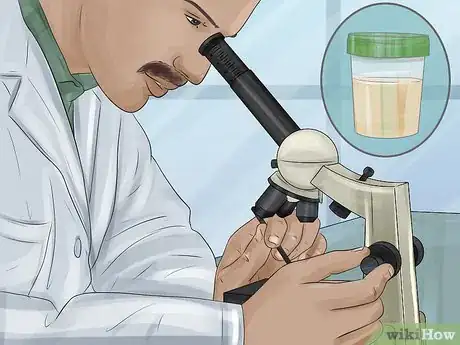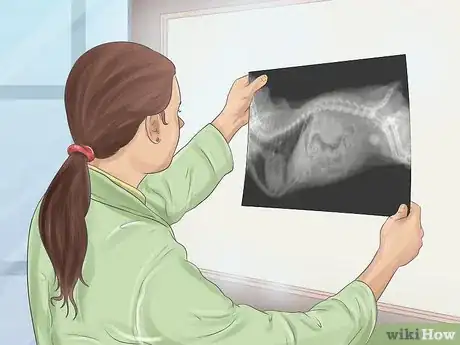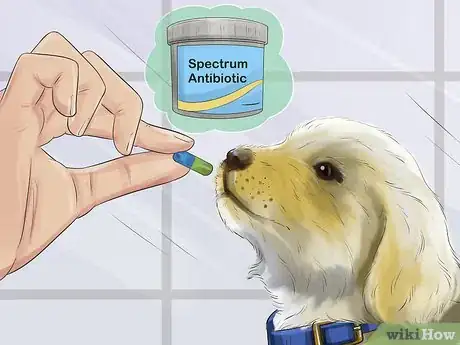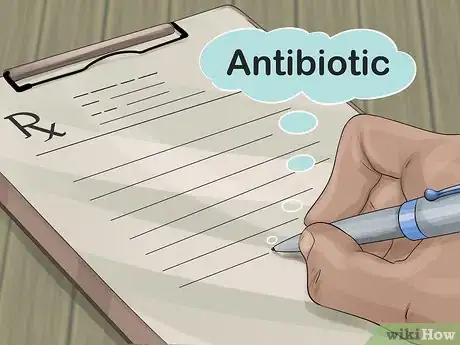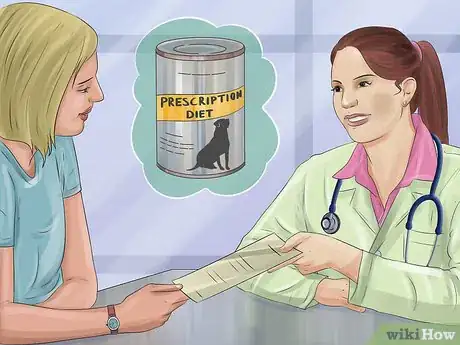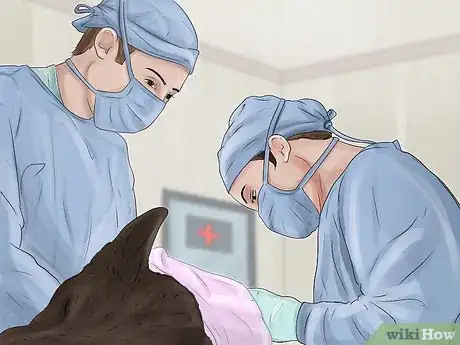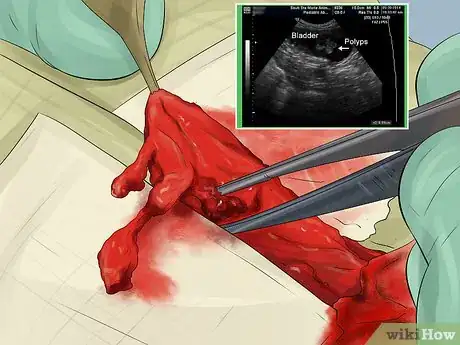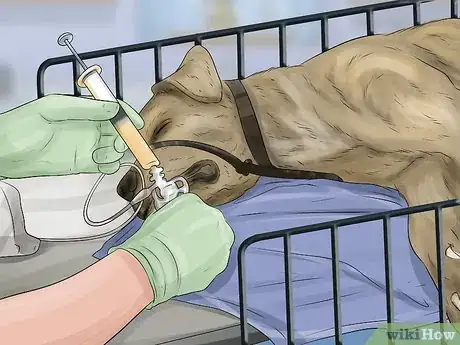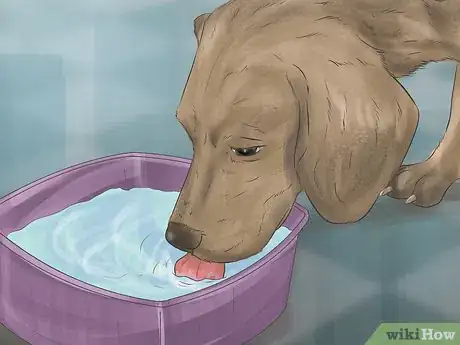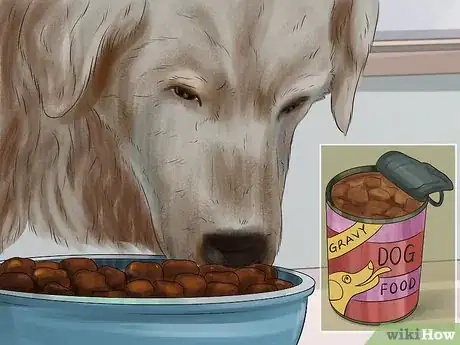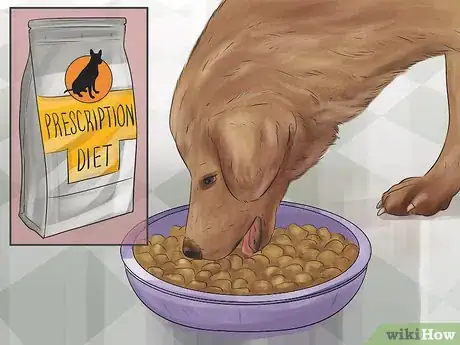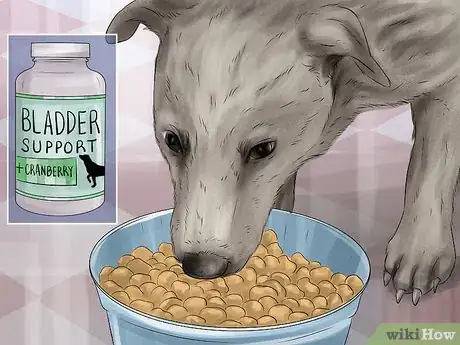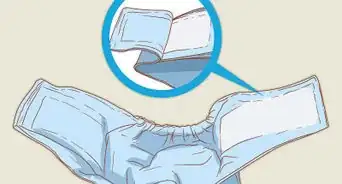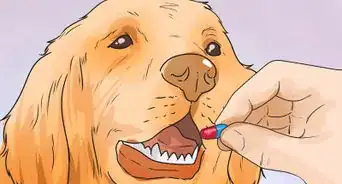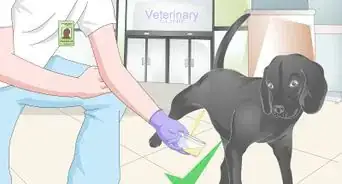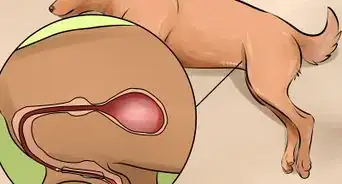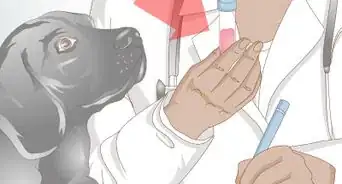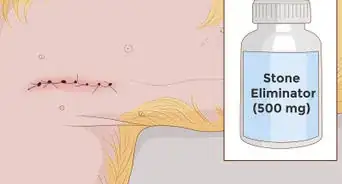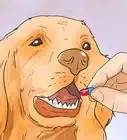This article was co-authored by Pippa Elliott, MRCVS. Dr. Elliott, BVMS, MRCVS is a veterinarian with over 30 years of experience in veterinary surgery and companion animal practice. She graduated from the University of Glasgow in 1987 with a degree in veterinary medicine and surgery. She has worked at the same animal clinic in her hometown for over 20 years.
There are 10 references cited in this article, which can be found at the bottom of the page.
This article has been viewed 30,370 times.
A bladder infection, also called cystitis, can be a very uncomfortable and dangerous condition for your dog. If you think your dog has a bladder infection, it is important to seek treatment from a veterinarian. You should also consider altering your dog’s diet, and working with your vet to treat underlying conditions that could be lead to more infections in the future.[1]
Steps
Determining the Cause of a Bladder Infection
-
1Identify the signs of a bladder infection. When a dog has a bladder infection, it will likely have physical and behavioral symptoms. It could have a variety of symptoms, which include:[2]
- Frequent urination
- Attempts to urinate (while only being able to pass a few drops)
- Increased thirst
- Fatigue
- Restlessness
- Blood in urine
- Urination accidents
- Signs of pain, including crying out and resistance to movement
- Excessive licking at the urinary tract opening
-
2Take your dog to be seen by a veterinarian. If your dog is exhibiting the signs of a bladder infection, then it needs to be treated by a veterinarian. Your vet will be able to assess the severity of the infection and create a treatment plan that will help clear up your dog's infection.[3]
- If you notice the signs of a bladder infection when your normal veterinary office is not open, contact an emergency veterinary hospital. Tell them about your dog's symptoms and discuss whether immediate treatment is needed.
Advertisement -
3Test the dog's urine to identify the cause of the bladder infection. When you bring your dog to the vet, tests should be done to determine the cause. These tests often include a urine sediment test, which can identify bacteria and urinary crystals, and a urine culture, which identifies bacteria in the urine.[4]
- With a urine sediment test, a sample of urine is centrifuged so that the debris settles to the bottom. A sample of this debris is put on a slide and examined under the microscope. This can identify any unusual bacteria and urinary crystals which could chaff the lining of the bladder.
- A urine culture involves growing the bacteria in the urine to check its sensitivity to different antibiotics. This helps to give a definitive answer as to whether infection is present or not.
-
4Have imaging done. It is often possible to identify the cause of infection, which could be urinary crystals, a bladder stone, a bladder polyp, or bladder cancer, with the help of imaging. Veterinary offices usually use either X-rays or ultrasounds, depending on what is available.[5]
- X-rays of the dog's abdomen can help identify bladder stones. However, not all stones show up on x-ray, depending on their mineral composition. Thus, ultrasound is a better test.
- Ultrasounds can detect bladder stones no matter what their mineral composition. Bladder stones often create similar symptoms to bladder infections.
Giving Your Dog Veterinary Treatment
-
1Give your dog a broad spectrum antibiotic. If your dog has a bladder infection, your veterinarian will often prescribe an antibiotic to get rid of it. You will have to give your dog its prescription antibiotic for 10 to 14 days, unless otherwise told otherwise by your veterinarian. [6]
- Broad spectrum antibiotics, such as amoxicillin-clavulanic acid (trade names Synulox or Clavamox), are often prescribed. This type of antibiotic works by destroying the bacterial cell membrane and causing it to implode.
- The dose is generally 12.5mg per kg twice a day by mouth. A 20kg dog needs a 250mg tablet twice a day.[7]
- Try to give the evening pill as late as possible, as this allows the antibiotic to sit in the bladder overnight.
-
2Give a second round of antibiotics, if necessary. After your dog has gotten its entire course of antibiotics, your veterinarian will test the dog again to make sure the infection is gone. If the bacteria are still alive, your veterinarian should prescribe a different antibiotic based on the results of the second urine culture. This second antibiotic is usually also a 2 week course. Your dog’s urine will be assessed after another 7 days have passed to make sure this second antibiotic is working.[8]
-
3Eliminate bladder crystals with dietary changes. Bladder crystals are a common cause of bladder infections. If bladder crystals are present, it is likely that your veterinarian will suggest putting the dog onto a specialized urinary tract diet. These specialty foods are designed to dissolve stones and prevent their further development.[9]
- Your veterinarian may suggest a prescription diet that can only be purchased through a veterinarian. These diets are more effective than the specialty diets available at pet stores.
-
4Consider surgery if crystals are numerous. If your vet thinks that your dog has too many crystals to be dissolved by a specialty diet, they may suggest surgical removal. This surgery should be followed by a dietary change to specialized food and a focus on hydration.[10]
-
5Remove bladder polyps with medication or surgical removal. Bladder polyps are benign growths that are another common cause of bladder infections in dogs. In some cases they can be resolved if the dog is put on an anti-inflammatory medication, such as meloxicam. This is a non-steroidal anti-inflammatory drug (NSAID) that can help to reduce inflammation. However, in many cases the polyps need to be removed surgically.[11]
- A dose of meloxicam is typically 0.05mg per kg by mouth once a day with or after food. The oral suspension contains 1.5mg per ml, so a typical 30kg Lab requires 1 ml daily with its food.[12]
-
6Give treatment for bladder cancer, but understand its limits. Bladder infections can be a side effect of bladder cancer. In most of these cases, treatment is largely palliative. While radiation and chemotherapy have been helpful to some dogs with bladder cancer, the long-term prognosis for this condition is generally poor.[13]
- Surgery is not typically a treatment option for bladder cancer. Unfortunately, bladder cancer tends to grow in an area of the bladder called the trigone. This is a vital area where the ureters are plumbed in, which makes bladder cancers poor candidates for surgery.
Preventing Future Bladder Infections
-
1Make sure your dog is drinking water every day. Lack of enough water is a common cause of urinary tract and bladder infections. To prevent dehydration, make sure fresh, clean water is always available to your dog. When your dog drinks plenty of fresh water, its urine will be more diluted, which helps to reduce the concentration of toxins in its system.[14]
- Putting ice cubes in your dog's water bowl on a hot day can entice the dog to drink.
- You should place a large water bowl in every room that the dog is likely to spend time in.
- Sometimes the sound of running water entices a dog to drink, so consider purchasing a pet drinking fountain.
-
2Feed your dog wet food. In order to get more water in your dog's diet, you can transition from dry kibble to canned food. Canned food contains quite a bit of water, so feeding your dog this food will help your dog's hydration.[15]
-
3Consider putting your dog on a prescription diet. Foods are available that promote the optimum urinary pH to discourage bacterial growth. They are also low in the minerals which promote crystals to form in the urine.[16]
- Talk to your veterinarian about what products might be right for your dog.
- There are some types of bladder infections that can be helped by prescription food, and some that cannot. This is why it is important to consult with your veterinarian about your dog's condition.
-
4Acidify your dog’s urine with vitamin C supplements. If your dog refuses to eat a prescription diet, then you can add vitamin C (ascorbic acid) to its diet. Adding acid to your dog's urine helps prevent infection, as dogs with alkaline urine are more prone to infection. The dose can vary but is typically 250 mg twice a day for a dog less than 10kg, and 500mg twice a day for dogs over 10kg.[17]
- Before acidifying your dog's urine, have a urinalysis done at its veterinary clinic. You want to make sure that it doesn't already have acidic urine, which is a pH of 6 or lower.[18]
- Stick with the recommended dose because if the urine becomes too acidic, this can irritate the bladder lining and mimic the symptoms of cystitis.
- Acidifying your dog's urine can cause bladder stones. Before giving your dog Vitamin C, ask your vet for advice.
-
5Give your dog cranberry juice or cranberry supplements. Cranberries contain proanthocyanidins, or "PACs," which decrease bacterial attachment to the lining of the bladder. With the bacteria less able to "stick" to the bladder, they are more easily washed away when the pet urinates. In order to give your dog this benefit, either give the dog [19]
- A dog that is 35 kilograms (77 lb) or less can be given 150mg of cranberry extract twice a day. A dog that is more than 35 kilograms (77 lb) can be given 300mg twice a day.[20]
- It is typically safe to give your dog cranberry juice or cranberry supplements in moderation. However, you should discuss this treatment with your veterinarian before proceeding.
Warnings
- Understand that it's difficult to differentiate between a bladder infection and obstruction. There is a big overlap in symptoms between bladder infections and obstructions. While infections are uncomfortable, obstructions can be life-threatening.⧼thumbs_response⧽
- If in doubt that your pet is fully emptying its bladder, always seek veterinary advice. It takes a professional to feel the patient's abdomen and determine if the bladder is small and tender (signs of bladder infection) or large and hard (signs of urinary obstruction).⧼thumbs_response⧽
References
- ↑ http://www.pethealthnetwork.com/dog-health/dog-diseases-conditions-a-z/bacterial-cystitis-dogs
- ↑ http://www.vetstreet.com/care/canine-bladder-infections
- ↑ http://www.pethealthnetwork.com/dog-health/dog-diseases-conditions-a-z/bacterial-cystitis-dogs
- ↑ https://vcahospitals.com/know-your-pet/cystitis-in-dogs
- ↑ https://vcahospitals.com/know-your-pet/cystitis-in-dogs
- ↑ Recurrent and persistent urinary tract infections in dogs. Norris & Williams. JAAHA, 36, 484-492
- ↑ Canine urinary tract infection. Detection, prevalence and therapeutic consequences. Thomsen et al. Nord Vet Med 38 (6), 394-402
- ↑ Recurrent and persistent urinary tract infections in dogs. Norris & Williams. JAAHA, 36, 484-492
- ↑ http://vetnutrition.tufts.edu/2017/07/dietary-treatment-of-bladder-stones/
- ↑ http://vetnutrition.tufts.edu/2017/07/dietary-treatment-of-bladder-stones/
- ↑ https://vcahospitals.com/know-your-pet/cystitis-in-dogs
- ↑ Canine urinary tract infection. Detection, prevalence and therapeutic consequences. Thomsen et al. Nord Vet Med 38 (6), 394-402
- ↑ https://bluepearlvet.com/medical-articles/bladder-tumors/
- ↑ https://www.vetinfo.com/common-dog-bladder-inf-sym.html
- ↑ https://www.vetinfo.com/common-dog-bladder-inf-sym.html
- ↑ http://vetnutrition.tufts.edu/2017/07/dietary-treatment-of-bladder-stones/
- ↑ Recurrent and persistent urinary tract infections in dogs. Norris & Williams. JAAHA, 36, 484-492
- ↑ https://www.whole-dog-journal.com/issues/2_11/answers_from_experts/Canine_Urinary_Problems_5242-1.html
- ↑ http://www.petmd.com/blogs/nutritionnuggets/jcoates/2013/nov/how-cranberry-can-be-used-to-prevent-urinary-infections-dogs-31002
- ↑ https://www.whole-dog-journal.com/issues/2_11/answers_from_experts/Canine_Urinary_Problems_5242-1.html
About This Article
A bladder infection can be very painful and dangerous for a dog, so you should take it to the vet if you suspect it has one. If the vet prescribes antibiotics, make sure to give the dog its medicine as directed for 10-14 days, or as long as it’s prescribed. To prevent bladder infections in the future, make sure your dog always has plenty of clean, cool water to drink, and ask your vet about supplements you can give your dog. Your vet may also recommend that you change your dog’s diet. Keep reading to learn more from our Veterinary co-author about how your vet may treat bladder infections!


